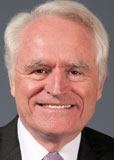Richard R. Sarles
2013 CEOs Who "Get It"

Richard R. Sarles
General Manager and CEO
Washington Metropolitan Area Transit Authority
Why is safety a core value at your organization?
RICHARD R. SARLES: We are an agency of 11,000-plus employees and more than a million passenger trips every day – and we believe profoundly in the responsibility we have to every one of those people to provide a safe workplace and safe travel for riders on trains and buses. It takes time, but we are working with all of our employees to put safety first in every aspect of our work and to go home in the same condition in which they came to work.
Describe your personal journey to becoming a CEO who "gets it." What experiences or lessons brought you to where you are now?
Safety has always been at the core of my work. I understood its importance in the earliest days of my career when I was a construction inspector working on rebuilding roadways adjacent to active traffic lanes, and that became amplified when we worked to bring electrification to the Northeast Rail Corridor while trains continued to operate between New Haven and Boston as part of the Acela high-speed rail project. It wasn't just about making sure safety standards were met, it was also about leading people and teams in a manner so that everyone felt comfortable telling the truth about every development along the way – even when the facts weren't popular – to ensure we were always putting safety at the forefront of our decision making.
As the executive director of NJ Transit, I was deeply moved by an accident that resulted in an employee fatality. The cause of his death was human error – lack of attention – and it struck me that it was preventable and that we needed to do more around right-of-way protection to actively alert our employees – engineering out human error to the greatest extent possible.
At WMATA, we have set about building a safety culture – from board-level policy to strategic investment in safe infrastructure and equipment, to employees feeling safe about reporting issues of concern. We are really tackling some of the tough areas ahead of the transit industry – such as fatigue management and close-call reporting, which few transit properties have done. There is no manual yet in these areas, no regulations – we are simply charting a course using good science and a lot of common sense.
What is the biggest obstacle to safety at your organization, and how do you work to overcome it?
There is no question that the biggest obstacle is complacency. When you have not had an incident, when injury ratios decline, when people have been trained and feel they can work on autopilot, that's when we have to redouble our efforts to raise awareness. Our workforce has to remind itself daily of every action needing to be safety-centered and to incorporate that awareness level into daily routines through safety briefings, peer-to-peer contact, good supervision and partnership with the safety department staff.
How do you instill a sense of safety in employees on an ongoing basis?
I think there are three important steps and the first one begins with really listening to employees. At WMATA, in my first year we conducted a safety survey and received very, very candid responses at a 98 percent participation rate. It's equally important to tell employees how conditions will be made safer, deliver on those commitments, and then provide and seek feedback. The cycle goes on, and the listening and commitment is perpetual.
How does your organization measure safety? What are the leading indicators that show you how safe your organization is, and where do you see room for improvement?
We measure safety by establishing key performance indicators and continually following up on progress. Leading indicators are results from field inspections, audits, issues identified at safety meetings with front-line employees, our Safety Measurement System, employee hotline calls and time to address to resolution, hazard identification and management to resolution, employee communications, customer communications, leadership site visits, and superintendent action reports at meetings.
What role does off-the-job safety play in your organization's overall safety program? What types of off-the-job safety and health programs does your organization offer to employees?
Off-the-job safety plays a big part in our daily activities, both at work and at. We have regular safety contacts with employees that remind them to work safely on the job and off the job (e.g., lawn care safety, driving safety, fire safety, hazardous material safety, cooking safety, etc.). Our safety communications address both on- and off-the-job safety. We are working to establish a fatigue risk management safety program that will educate employees on the importance of sleep and what steps they can take to avoid fatigue, including wellness, diet, exercise and rest.
Washington Metropolitan Area Transit Authority is the transit provider for the national capital region, with more than 11,000 employees serving more than 1.3 million passenger trips daily on Metrorail, Metrobus and paratransit services. WMATA's mission is to provide safe, equitable, reliable and cost-effective public transit.

